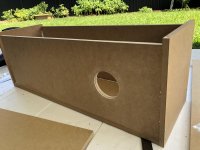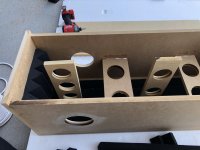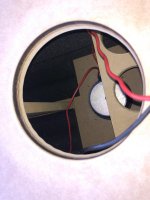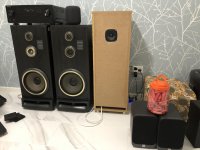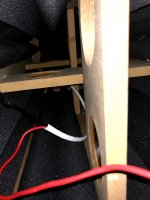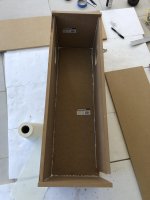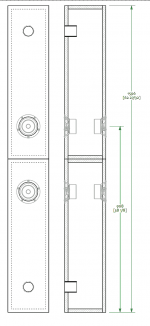Whatever you do, don’t attempt “final” cutting of materials or begin assembly until you have the drivers in hand to dry fit, particularly if following some of the more elaborate bracing schemes that couple the magnet assembly to the enclosure. Whichever model(s) you finally elect, also note that as a general rule, FR drivers “breathe” best with the rear side of cutout chamfered - to my thinking as deeply as panel thickness permits.
Okay! Call me an impulsive.
Despite the advise from Chris, I ended up building one speaker cabinet from the measurement Dave provided. For now, I have only built one to test and learn, and reused the Dayton drivers that I had from previous build, and will replace these once, I am able to get the Pluvia 7.
Given the current situation, I cannot get the MA Pluvia 7 drivers, but that didn't stop me building the cabinet for it. After all, what else is there to do, when you are trying to isolate your self from world.
By the way, I went with MDF as plywood at local store was quite a bit expensive for 19mm sheet at $88, and I would need two sheets for one cabinet. Also the MDF is 16mm thick, as that was the thickest I could get from that store.
It ended up great. Even with the Dayton's driver the bass has improved a lot and does sound big. It is a bipole speaker with one driver in front and second one in the back. Once I get the drivers, I will work to build a second cabinet and then decide if I want to stack them and use it as quadruple or separate them and use it as stereo left and right.
Here are some pictures of the build.
I ended up using acoustic foam to line the cabinet walls, as I had few to spare instead of polyfill. As for the braces, I cut 5 pieces of MDF and cut couple of holes using holesaw and glued them wall to wall in the middle.
Despite the advise from Chris, I ended up building one speaker cabinet from the measurement Dave provided. For now, I have only built one to test and learn, and reused the Dayton drivers that I had from previous build, and will replace these once, I am able to get the Pluvia 7.
Given the current situation, I cannot get the MA Pluvia 7 drivers, but that didn't stop me building the cabinet for it. After all, what else is there to do, when you are trying to isolate your self from world.
By the way, I went with MDF as plywood at local store was quite a bit expensive for 19mm sheet at $88, and I would need two sheets for one cabinet. Also the MDF is 16mm thick, as that was the thickest I could get from that store.
It ended up great. Even with the Dayton's driver the bass has improved a lot and does sound big. It is a bipole speaker with one driver in front and second one in the back. Once I get the drivers, I will work to build a second cabinet and then decide if I want to stack them and use it as quadruple or separate them and use it as stereo left and right.
Here are some pictures of the build.
I ended up using acoustic foam to line the cabinet walls, as I had few to spare instead of polyfill. As for the braces, I cut 5 pieces of MDF and cut couple of holes using holesaw and glued them wall to wall in the middle.
Attachments
Pluvia 7 Gold
and a step up: Mark Audio 7M Gold
Althou the 1st one is a bass monster (relatively), and is voiced similarly, the Alpair is capable of better low level resolution/DDR.
dave
Note that despite being called gold these drivers are copper in colour, and can also be had in silver (called grey i think).
Hi Dave,
Just wanted to confirm the driver above.
Should I be getting Pluvia 7 or Pluvia 7.2HD?
While trying to find these on the net, I came across Pluvia 7.2HD being the new driver. So, just wanted to confirm, which one I should be getting, and which one is better.
Anyone interested in a 'Bipolar MLTL' designs and history can also search the DIYaudio forum for details. My name will show up in many threads. My designs for the CSS 125 drivers and their Mark Audio built EL70 drivers (forerunners of the MA 70 series drivers) are included in this search.
Of interest to you would be my design details for my prototypes. Other DIY'ers have duplicated these designs and have reported excellent performance. In the postings from your search read this post on placement of bipolar MLTL speakers at:
Who's had both?
The performance and especially Fred Thompson's impressions on his units built from my plans are in a posting on another forum. See this at:
Best Sounding Single Drivers
Of interest to you would be my design details for my prototypes. Other DIY'ers have duplicated these designs and have reported excellent performance. In the postings from your search read this post on placement of bipolar MLTL speakers at:
Who's had both?
The performance and especially Fred Thompson's impressions on his units built from my plans are in a posting on another forum. See this at:
Best Sounding Single Drivers
Should I be getting Pluvia 7 or Pluvia 7.2HD?
I have a pair of the latter, but not done much work with it. It is supposed to be a derivative using A7.3 parts, so in theory would be a better driver (mostly in DDR), but won’t go near as low. The designs presented are for the original P7.
dave
….and their Mark Audio built EL70 drivers (forerunners of the MA 70 series drivers) are included in this search.
The Pluvia 7 fits into pretty much the same boxes as the EL70 (both f these only come in just behind the A10.2 in terms of bass extention (ignoring the A12pw). The current CHPs are quite different box wise.
dave
Dave,
I would not suggest that my early EL70 designs are amenable to any of the later Mark
Audio drivers. Some spec differences are likely to mean that enclosure changes are needed for the latest drivers in the Pluvia 7 series and even the earlier Alpair 7 drivers. I have not done a MLTL for the latest drivers but they would be interesting bipolar speakers.
Jim
I would not suggest that my early EL70 designs are amenable to any of the later Mark
Audio drivers. Some spec differences are likely to mean that enclosure changes are needed for the latest drivers in the Pluvia 7 series and even the earlier Alpair 7 drivers. I have not done a MLTL for the latest drivers but they would be interesting bipolar speakers.
Jim
I would not suggest that my early EL70 designs are amenable to any of the later Mark Audio drivers.
That was my take, just wanted no-one to build your cabinet and put the wrong drivers in.
The P7 thou, should work in the EL70 bipole.
http://p10hifi.net/planet10/CSS/EL70/Griffin-offset-bipole-mltl-100909.pdf
Some spec differences are likely to mean that enclosure changes are needed for the latest drivers in the Pluvia 7 series and even the earlier Alpair 7 drivers
I use the size of my optimum miniOnkens as a generic to guage box size. That is 13 litres for EL70/P7/CHP70, 9 litres for A7.x/CHP70.2/CHR70x. The ones in the bigger boxes go lower but give up some sensitivity.
dave
One more question.
My Pluvia 7 are on the way and should arrive in next couple of days.
How should I wire them?
Previously, I was planning on 4 drivers per cabinet, but now after building the cabinet, I realise the for 4 drivers, the cabinet needs to be rather large. So, now I am going for 2 drivers per cabinet.
These are rated 8ohms drivers, and wiring them would either results in 4ohms or 16ohms load. Not sure, what is better. Any advice?
My Pluvia 7 are on the way and should arrive in next couple of days.
How should I wire them?
Previously, I was planning on 4 drivers per cabinet, but now after building the cabinet, I realise the for 4 drivers, the cabinet needs to be rather large. So, now I am going for 2 drivers per cabinet.
These are rated 8ohms drivers, and wiring them would either results in 4ohms or 16ohms load. Not sure, what is better. Any advice?
Per the renders above, I've just finished a stackable bipole design for the current P7HD with dimensions optimised as far as possible assuming a pair will be stacked for use as a quadrupole.
Needs to pass thru QC. Considering it a further optimization of the miniTower. The top driver could come down some 24 mm by making it monolithic and making it out of 15mm (more than adequate — with drivers well coupled 12mm would be sufficient. A 7” (inside) square prism 30” tall.
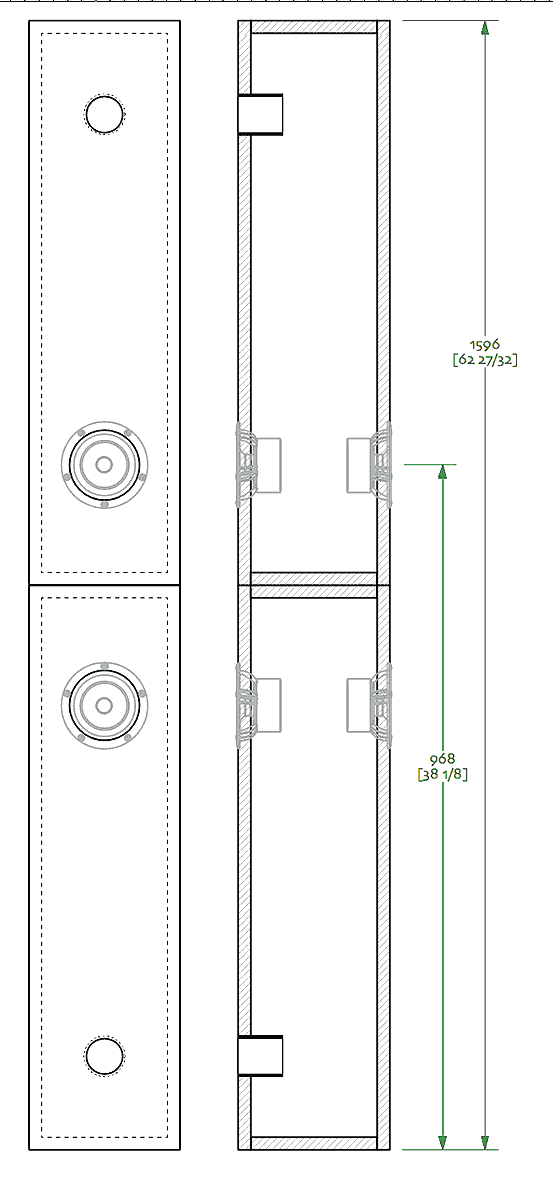
dave
dave
Attachments
Looks good. 🙂 If a quadrupole was wanted, then absolutely, just make it a monolithic single enclosure; that will immediately chop 12mm - 15mm off the height as only a single solid internal divider would be necessary. Edit* This is design on the fly as it were; I've been able to adjust the tap location to get the upper drivers a little lower when run as a quadrupole. The sound you hear is Dave preparing one of his inventory of personal ICBMs for a strike on my house.
As I put in my email to Dave, my thinking on this one was that the lower section would have the lateral-radiating driver pair, the upper the front-rear radiating pair to place the direct radiation from the front unit nearer a typical ear-height.
Quadrupoles are unusual variation on the near-omni theme; EPI's are the only relatively successful commercial example that I'm relatively familiar with notwithstanding the HF units on, say, Infinity's Holosonic.
As I put in my email to Dave, my thinking on this one was that the lower section would have the lateral-radiating driver pair, the upper the front-rear radiating pair to place the direct radiation from the front unit nearer a typical ear-height.
Quadrupoles are unusual variation on the near-omni theme; EPI's are the only relatively successful commercial example that I'm relatively familiar with notwithstanding the HF units on, say, Infinity's Holosonic.
Last edited:
The sound you hear is Dave preparing one of his inventory of personal ICBMs for a strike on my house.
2nd pass just despatched.
dave
Well my pluvia 7 are still stuck in freight, should have arrived two days before but they are still in sender's state.
More wait.
More wait.
This is a nice design and bit smaller than previous build.
- Home
- Loudspeakers
- Full Range
- Fullrange Bipole MLTL speaker build
